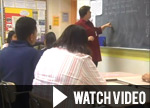Parents → Academic programs → Services for English Language Learners
Services for English Language Learners

Overview
Upon enrollment, students whose native language is not English are tested to determine their level of proficiency in English and what services may be required. Determination of the level of placement for English for Speakers of Other Languages (ESOL) services is made by the professionals at each school.
All elementary and most middle schools offer ESOL instructional programs. High school students receive ESOL instruction at 19 school centers. As students progress through the advanced levels of proficiency in English, they may exit the ESOL program and no longer receive ESOL instruction. ESOL support services help students and families adjust to the school system and to a new culture.
ESOL Academic Instruction
 Elementary school—Students receive English language instruction from an ESOL teacher on a regularly scheduled basis. All students are in regular education classrooms with non-ESOL students for most of the school day.
Elementary school—Students receive English language instruction from an ESOL teacher on a regularly scheduled basis. All students are in regular education classrooms with non-ESOL students for most of the school day.
Middle school—Students receive daily English language instruction. Beginning and low-intermediate students receive two ESOL classes daily; advanced ESOL students receive one ESOL class per day.
High school—Beginning and low-intermediate students receive two ESOL classes daily. All others receive a minimum of one ESOL class per day. In addition to daily English language instruction, students at the lower proficiency levels are scheduled into content classes such as history, math and science. They also participate in regular classes with non-ESOL students.
Additional Information
Multidisciplinary Educational Training and Support (METS)
This program is designed for students in Grade 3 through high school who have had interrupted or no schooling in their own countries. Students enrolled in the METS program receive daily instruction in basic literacy skills, in addition to social skills needed for school.
Additional Information
Students Engaged in Pathways to Achievement (SEPA)
SEPA is a career-based instructional program for Spanish-speaking high school ESOL students who have experienced interrupted or limited formal education. To be eligible for the SEPA program, students must be at least eighteen years of age at the start of their first school year in the SEPA program. The SEPA program is currently available to students at a limited number of high schools.
Additional Information